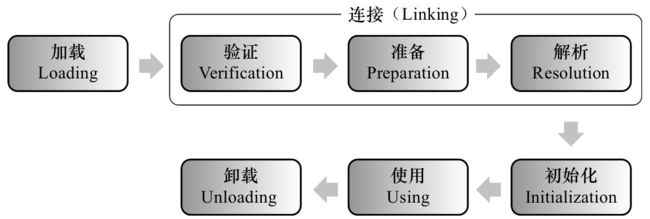插件化框架实现:基于kotlin的插件化框架
Java类加载
- 我们知道Java代码通过编译成class文件后,需要通过类加载机制加载到虚拟机后才能运行
类加载机制
加载阶段
- 通过类的全限定名获取二进制字节流(可以来自磁盘,网络等),将字节流装换为方法区的数据结构,生成Class对象作为该类访问入口
连接阶段
- 验证Class的字节流符合虚拟机规范,为类变量分配内存初始化默认值,将常量池符号引用转化为直接引用
初始化阶段
- 执行类构造器:静态语句块和类变量赋值动作
- 初始化的触发时机是在遇到new、invokestatic、反射、父类还没初始化等操作时进行
Java 类加载器
-
启动类加载器(Bootstrap ClassLoader)
负责将
/lib -
扩展类加载器(Extension ClassLoader)
负责加载
\lib\ext -
应用程序类加载器(Application ClassLoader):一般程序的默认类加载器
负责加载用户类路径(
ClassPath)的类库
类加载器的双亲委托模型
- 如果一个类加载器收到了类的加载的请求,它首先不会自己去加载这个类,而是把这个请求委托给父类加载器去完成,每一层都是如此;因此所有的加载请求最终都应该传递到顶层的启动类加载器中,只有当父类加载器反馈无法完成这个加载请求(它的搜索范围内没有找到所需的类)时,子加载器才会尝试去加载
- 同时类加载方式也分为隐式加载(new等方式)和显示加载
Class.forname(xxx)
Android类加载
- Android不是基于jvm虚拟机,不能直接加载class字节码,需要将class字节码转换为dex字节码
Android 类加载器
Android类加载器主要是DexClassLoader和PathClassLoader,两者的区别是:
PathClassLoader是系统类加载器,同时也是默认类加载,只能加载系统中已经安装过的apk
DexClassLoader可以加载apk/dex,可以加载未安装的apk
DexClassLoader版本差异
- Android在API 9-13 和API 14以上DexClassLoader内部持有dex文件的数据结构不同,如果需要设配API 9-13则需要做不同处理,先来看一下数据结构不同的地方:
API 9 - 13
DexClassLoader
public class DexClassLoader extends ClassLoader {
private static final boolean VERBOSE_DEBUG = false;
/* constructor args, held for init */
private final String mRawDexPath;
private final String mRawLibPath;
private final String mDexOutputPath;
/*
* Parallel arrays for jar/apk files.
*
* (could stuff these into an object and have a single array;
* improves clarity but adds overhead)
*/
private final File[] mFiles; // source file Files, for rsrc URLs
private final ZipFile[] mZips; // source zip files, with resources
private final DexFile[] mDexs; // opened, prepped DEX files
// ....
}
- 这里可以看到DexFile是直接以数组结构存放在DexClassLoader类中
API > 13
DexClassLoader相关类
public class DexClassLoader extends BaseDexClassLoader {
public DexClassLoader(String dexPath, String optimizedDirectory,
String librarySearchPath, ClassLoader parent) {
super(dexPath, new File(optimizedDirectory), librarySearchPath, parent);
}
}
public class BaseDexClassLoader extends ClassLoader {
private final DexPathList pathList;
public BaseDexClassLoader(String dexPath, File optimizedDirectory,
String librarySearchPath, ClassLoader parent) {
super(parent);
this.pathList = new DexPathList(this, dexPath, librarySearchPath, optimizedDirectory);
}
// ...
}
final class DexPathList {
/** class definition context */
private final ClassLoader definingContext;
/**
* List of dex/resource (class path) elements.
* Should be called pathElements, but the Facebook app uses reflection
* to modify 'dexElements' (http://b/7726934).
*/
private Element[] dexElements;
// ...
static class Element {
private final File dir;
private final boolean isDirectory;
private final File zip;
private final DexFile dexFile;
// ...
}
}
- 这里可以看到DexFile被层层封装存放在BaseDexClassLoader的DexPathList中
ODEX过程
- android 虚拟机并不是直接读取dex文件的,在安装apk的时候会做一次优化,在这一过程,由虚拟机控制的一个verify选项,如果开启会进行一次校验,如果某个类没有引用其他dex中的类,这个类会被打上CLASS_ISPREVERIFIED 的标志。一旦被打上这个标志,就无法再从其他 dex 中加载这个类了
- 这个问题的比较简单的解决办法是引用其他dex的类
App ClassLoader Hook点
- 我们知道App启动会初始化Application并且调用onCreate,这其实是在接受AMS启动信息后调用ActivityThread的handleBindApplication,函数过长,下面截取关键代码:
private void handleBindApplication(AppBindData data) {
// ...
data.info = getPackageInfoNoCheck(data.appInfo, data.compatInfo);
// ...
final ContextImpl appContext = ContextImpl.createAppContext(this, data.info);
// 下面代码中也创建ContextImpl,这里应该需要先用到ContextImpl的信息,这里
// 创建ApplicationInfo
ApplicationInfo instrApp = new ApplicationInfo();
instrApp.packageName = ii.packageName;
instrApp.sourceDir = ii.sourceDir;
instrApp.publicSourceDir = ii.publicSourceDir;
instrApp.splitSourceDirs = ii.splitSourceDirs;
instrApp.splitPublicSourceDirs = ii.splitPublicSourceDirs;
instrApp.dataDir = ii.dataDir;
instrApp.nativeLibraryDir = ii.nativeLibraryDir;
// 获取或创建LoadedApk
LoadedApk pi = getPackageInfo(instrApp, data.compatInfo,
appContext.getClassLoader(), false, true, false);
ContextImpl instrContext = ContextImpl.createAppContext(this, pi);
try {
java.lang.ClassLoader cl = instrContext.getClassLoader();
mInstrumentation = (Instrumentation)
cl.loadClass(data.instrumentationName.getClassName()).newInstance();
} catch (Exception e) {
throw new RuntimeException(
"Unable to instantiate instrumentation "
+ data.instrumentationName + ": " + e.toString(), e);
}
mInstrumentation.init(this, instrContext, appContext,
new ComponentName(ii.packageName, ii.name), data.instrumentationWatcher,
data.instrumentationUiAutomationConnection);
// ...
// 创建Application
Application app = data.info.makeApplication(data.restrictedBackupMode, null);
mInitialApplication = app;
// 调用Instrumentation的onCreate()方法
mInstrumentation.onCreate(data.instrumentationArgs);
// 调用Application的onCreate()方法
mInstrumentation.callApplicationOnCreate(app);
}
- 上面代码有两个LoadedApk对象,分别是
data.info和pi,由下面获取LoadedApk代码可以知道都是同一个LoadedApk对象
public final LoadedApk getPackageInfoNoCheck(ApplicationInfo ai, CompatibilityInfo compatInfo) {
return getPackageInfo(ai, compatInfo, null, false, true, false);
}
private LoadedApk getPackageInfo(ApplicationInfo aInfo, CompatibilityInfo compatInfo,
ClassLoader baseLoader, boolean securityViolation, boolean includeCode,
boolean registerPackage) {
// 根据包名加载缓存中的LoadedApk 或 创建LoadedApk
}
- 到这里我们知道ClassLoader来自
appContext.getClassLoader(),代码跟踪最终调用LoadedApk的getClassLoader()方法
public ClassLoader getClassLoader() {
synchronized (this) {
if (mClassLoader != null) {
return mClassLoader;
}
if (mIncludeCode && !mPackageName.equals("android")) {
// ...
mClassLoader = ApplicationLoaders.getDefault().getClassLoader(zip, lib,
mBaseClassLoader);
} else {
if (mBaseClassLoader == null) {
mClassLoader = ClassLoader.getSystemClassLoader();
} else {
mClassLoader = mBaseClassLoader;
}
}
return mClassLoader;
}
}
- 可以看到LoadedApk属性mClassLoader就是整个App的使用的ClassLoader
ZenusPlugin 类加载
- 通过替换系统LoadedApk的ClassLoader为ZeusClassLoader,利用ZeusClassLoader优先查找补丁中的类,若存在就返回,不存在则再查找宿主中的类
- 优先查找补丁中的类是先通过反射宿主ClassLoader的parent来完成
ZeusClassLoader
- 空ClassLoader,容器作用
- ZeusPluginClassLoader[],每个插件对应一个ZeusPluginClassLoader
ZeusHotfixClassLoader
- 补丁包类加载器,加载补丁包的时候会替换插件包的parent ClassLoader
加载插件代码
/**
* 启动插件
*
*/
public void startPlugin() {
PluginManager.loadLastVersionPlugin(MyApplication.PLUGIN_TEST);
try {
Class cl = PluginManager.mNowClassLoader.loadClass(PluginManager.getPlugin(MyApplication.PLUGIN_TEST).getPluginMeta().mainClass);
Intent intent = new Intent(this, cl);
//这种方式为通过在宿主AndroidManifest.xml中预埋activity实现
// startActivity(intent);
//这种方式为通过欺骗android系统的activity存在性校验的方式实现
PluginManager.startActivity(this,intent);
} catch (ClassNotFoundException e) {
e.printStackTrace();
}
}
Small 类加载
- 通过单ClassLoader模式,通过反射Application的ClassLoader将插件包的dex文件添加到DexClassLoader中,通过添加到DexFile Array Head实现插件化
VirtualAPK
- 具备单ClassLoader和多ClassLoader模式,具体是可配置的,默认是单ClassLoader结合多ClassLoader
- apk直接作为插件,在VirtualAPK中被封装成LoadedPlugin,LoadedPlugin具有自己的DexClassLoader,同时根据配置判断是否将LoadedPlugin的DexClassLoader中DexPathList合并到宿主ClassLoader
单ClassLoader vs 多ClassLoader
- 当加载某个类的时候,如果不知道在哪个插件,通过单ClassLoader直接查找比较方便,但是查找过程比多ClassLoader小范围查找会比较慢
- 多ClassLoader需要管理多个ClassLoader,单新的补丁插件来时需要替换等操作,不像单ClassLoader模式,直接将新插件dex文件置于DexPathList头部即可
- VirtualAPK采用两个模式,其实是一种中和,当不知道要启动的类在哪个插件则可以直接通过Class.forName查找,当知道要启动的类在哪个插件则可以通过对应LoadedPlugin的API查找
